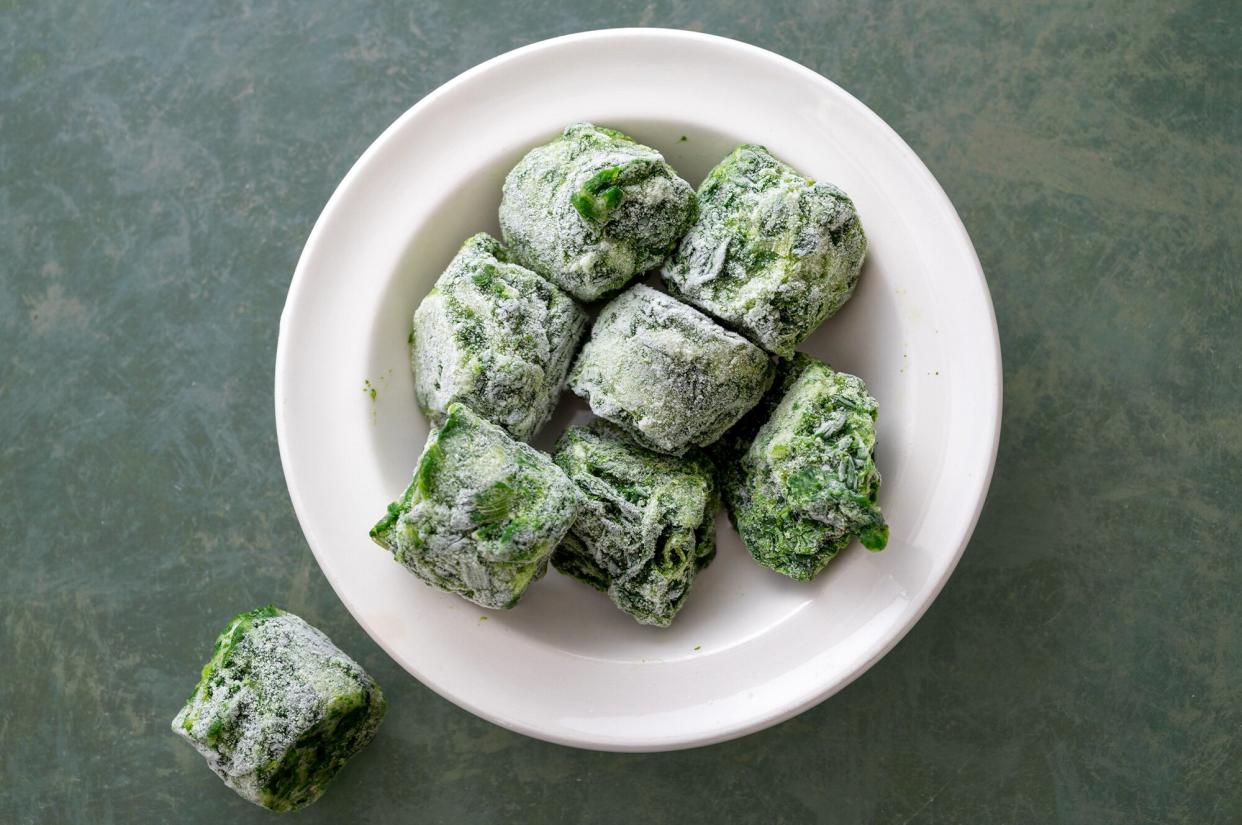Why You Should Always Have a Bag of Spinach in Your Freezer—Plus, How to Defrost and Cook With It

Gingagi / Getty Images
TABLE OF CONTENTS
On This Page
Health Benefits
Types of Frozen Spinach
How to Freeze Fresh Spinach
How to Defrost Frozen Spinach
How to Cook with Frozen Spinach
Spinach is a valued vegetable for many reasons—it shines in salads, wilts quickly in pastas and other cooked dishes, and has a plethora of health benefits. One downside to the leafy green that often deters people from buying it, however, is that spinach often spoils quickly. But there's a solution to this—buying frozen spinach or freezing fresh spinach before it has the chance to go bad. If you've never worked with frozen spinach in your kitchen, you may have some questions; does it still have the same nutritional properties as fresh spinach? How will long it keep in the freezer? And how best to cook with it. Once you know the answers to these common queries, you're sure to be "team frozen spinach" and always have a bag in your freezer.
Related: Add More Greens to Your Weekly Meals with These 30 Spinach-Heavy Recipes
Health Benefits
Like other dark leafy greens, spinach contains a lot of vitamin A, iron, calcium, vitamin K, folate, and potassium. "Not to mention the phytochemicals and fiber that are so crucial to health and chronic disease prevention," says Jen Bruning, MS, RDM, LDN, a spokesperson for the Academy of Nutrition and Dietetics. While frozen spinach maintains many of these same properties, Bruning does note that blanching spinach—the process of briefly boiling it then shocking it in an ice bath—may cause a little bit of nutrient loss, but the amount is negligible. "Fresh or frozen spinach is great—it's a powerhouse of nutrient goodness," she says.
Types of Frozen Spinach
When shopping for spinach in the freezer aisle of your local grocery store, you may see a handful of different options. "There's plain, but also some that may have added salt, or come in a sauce," Bruning says. "Opt for plain to have the most versatility, without added sodium or fat." You'll also see different cuts of frozen spinach (whole leaf and chopped) notes Celine Beitchman, director of nutrition at the Institute of Culinary Education. She recommends choosing what fits your budget and affirms Bruning's sentiment about avoiding added salt.
How to Freeze Fresh Spinach
If you want to extend the life of fresh spinach, store it in the freezer until you're ready to use it. However, when you buy frozen spinach from the store it is already cooked, which is how it gets its texture. For that reason, you'll need to cook the fresh spinach before storing it in the freezer. Beitchman says you can do this by blanching the spinach—cook it in boiling water for about three minutes, then drain it and shock it in an ice bath. Alternatively, you can sauté it in a pan with oil and other seasonings.
"Once cooked, store cooled spinach in airtight containers. Label and date whatever you freeze to help you keep track of its quality," Beitchman says. Frozen spinach will last in the freezer for about three months, but if you bought it from the store already frozen, Bruning says to follow the sell-by date.
How to Defrost Frozen Spinach
When you're ready to defrost frozen spinach, place it on a plate or other container to catch condensation says Bruning. "If you need it quickly, thaw under cold running water," she says. "And if you only need a portion or two from a larger bag, transfer what you need into a zip top bag for defrosting." Let the spinach thaw overnight then use it as needed.
How to Cook with Frozen Spinach
Defrosted frozen spinach can be added to any recipe that calls for leafy greens. "Once defrosted, squeeze out excess water, and add to fritter batters, smoothies, soups, stew, a pot of creamy beans, or my favorite, as a lasagna layer," Bruning says.
It is possible to cook with spinach directly from frozen, rather than defrosting it first, but this only works for certain dishes. Bruning says you can use frozen spinach in applications, like adding it into soup, but she notes that this may lead to uneven cooking. "It may also cause more liquid to run off than if you thaw it first and squeeze out excess liquid in a towel or sieve, so this doesn't work well for casseroles or stir frys," she says. Beitchman suggests offsetting any excess water in a dish like soup by adding in other ingredients or by reducing the mixture over high heat.

